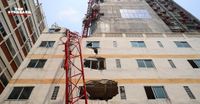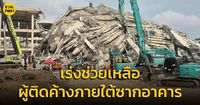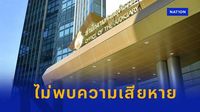On March 29, 2025, following a significant earthquake that struck Taiwan, the aftermath was felt across Thailand, particularly in Bangkok where extensive damage to high-rise buildings and condominiums was reported. The earthquake, which occurred on March 28, caused tremors that were detectable in 63 provinces, including the capital city.
According to a report by THE STANDARD, structural assessments revealed cracks in several buildings, especially in areas near roads, junctions, and ongoing construction sites. Some buildings showed visible signs of distress, such as damaged connectors and pavement fractures. Additionally, construction cranes were reported damaged, and debris from buildings fell onto vehicles, causing further concerns.
In response to the disaster, Bangkok Governor Chadchart Sittipunt announced that 130 engineers would be deployed to inspect both government and private buildings over the next two to three days to ensure safety and reassure the public. Governor Sittipunt emphasized the importance of 24-hour monitoring to keep citizens informed and alleviate their concerns.
As part of the ongoing efforts, inspections are set to take place in six key areas: Suan Luang, Uthayan Benjasiri, Suan Lumphini, Suan Chatuchak, Suan Rot Fai, and Suan Santiphap. The governor also ordered public parks to remain open 24 hours a day, providing a safe space for residents feeling uneasy about returning to their homes.
On March 30, 2025, at 19:00, the Department of Disaster Prevention and Mitigation (DDPM) updated the public on the situation. Mr. Phasakorn Bunyalak, the Deputy Director-General of the DDPM, reported that aftershocks ranging from 2.8 to 7.1 magnitude had occurred 177 times since the initial quake, but these aftershocks were not expected to cause further significant damage.
The DDPM confirmed that 18 provinces, including Bangkok, experienced varying degrees of damage. Reports indicated that in Bangkok alone, there were 12 fatalities, 9 serious injuries, and 76 individuals reported missing. Damage assessments revealed that 591 houses, 55 temples, 86 hospitals, 52 schools, and 25 government buildings were affected.
In light of the extensive damage, the DDPM has coordinated with the Royal Thai Army and international organizations to provide assistance to those affected, particularly in Bangkok where the need is most urgent. The department is also preparing to offer aid to Taiwan, including sending a USAR team of 77 personnel equipped with necessary disaster relief supplies.
As the situation continues to evolve, the Bangkok Metropolitan Administration (BMA) is working closely with the DDPM to conduct thorough inspections of damaged buildings and ensure the safety of residents. The BMA has stated that they are committed to providing timely assistance and support to those affected by the disaster.
In a related update, the Sal news outlet reported on March 30, 2025, that the Office of the Judiciary in Thailand conducted inspections of court buildings nationwide following the earthquake. Fortunately, no significant damage was found to the foundational structures or essential systems such as electrical and plumbing. Minor repairs were noted in some locations, primarily related to cosmetic damage like cracked tiles and walls.
As a precaution, the judiciary announced that court hearings scheduled for March 31, 2025, would be postponed to ensure the safety of personnel and the public. Specific courts, including the Central Juvenile and Family Court and the Central Bankruptcy Court, have communicated with the public regarding rescheduling and alternative arrangements for legal proceedings.
In light of the ongoing recovery efforts, local authorities have urged residents to stay vigilant, especially as weather forecasts indicate potential thunderstorms and high winds in the coming days. The DDPM has recommended that citizens avoid open areas and unstable structures during adverse weather conditions.
As Thailand navigates the challenges posed by this natural disaster, government officials are emphasizing their commitment to ensuring the safety and well-being of all citizens. The DDPM is actively coordinating with various agencies to provide comprehensive support and expedite recovery efforts across affected regions.
In summary, the earthquake has prompted a swift and robust response from both local and national authorities, highlighting the importance of preparedness and resilience in the face of natural calamities. The collective efforts of engineers, disaster response teams, and government officials are crucial in restoring normalcy and ensuring the safety of the public during this critical time.








